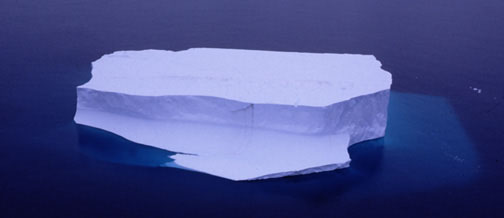
About 7/8ths of an iceberg is below the water line. This figure is approximate. Although icebergs are similar, not all are the same. Varying factors are iceberg density, water density etc. Keep in mind we are talking about an iceberg's mass. Due to irregular iceberg shapes, icebergs may have varying heights out of the water, but mass is relatively consistent. The following provides further background information:
Buoyancy
Buoyancy is the upward force exerted on an object immersed in a fluid. Of course, water is the most common fluid, but buoyancy also applies to hot air balloons (where the fluid is the surrounding air) and many other situations. What's the basic idea?
Archimedes figured out that the key to buoyancy is how much volume the object displaces compared to its weight. Archimedes Principle of buoyancy states that the upward force on an object in a fluid is equal to the weight of the fluid that is displaced. If this bouyant force is less than the weight of the object itself, the object will be left with a net downward force and will sink. If the object floats, it floats enough that the bouyant force exactly balances its weight.
For solid, uniform objects like an iceberg, this boils down to the object's mass density, its mass divided by its volume, usually represented by the Greek letter . For something like a boat hull, which is hollow, not uniform, you have to just look at the total weight and the volume of displaced water.
Example: Icebergs
So let's take the case of the iceberg. Lets say it has mass Mi and volume Vi. Their ratio is given by the mass density of ice: M/V = Rhoi ~ 0.90 g/cm3 (iceberg ice is more dense than normal ice since it has been compressed by thousands of years of pressure - normal ice is 0.917 g/cm3). Since we already know it floats, lets say that the volume below the surface of the water is Vw. This is the volume of water displaced, and the buoyant force is equal to the weight of that displaced water, which has mass Mw = VwRhow. The mass density of liquid water was originally used to define the gram, so it has the convenient metric value = 1 g/cm3. Sea water on the other hand is more dense since it has salts, therefore we shall use Rhow = 1.035 g/cm3 (or 1035 kg/m3).
The weight of an object is given by its mass times the acceleration of gravity, g = 9.8 m/s2:
W = Mg
The iceberg has weight Wi = Mig and the buoyant force is equal to the weight of the displaced water, Ww = Mwg. Furthermore, since the iceberg is floating, its weight exactly balances the buoyant force:
Ww = Wi
Mwg = Mig
VwRhowg = ViRhoig
Vw = Rhoi/Rhow Vi
So, the fraction of ice underwater, Vw/Vi, is given by the ratio of densities Rhoi/Rhow=0.87. Over 87% of an iceberg's volume (and mass) is underwater. As you can see, the convenient definition of the gram gives us a quick way to see how much of a floating substance lies below the surface of fresh water: the fraction is equal to that substance's mass density in g/cm?.
Summary
- Archimede's Principle of bouyancy states that the bouyant force on an object is equal to the weight of the fluid displaced by that object.
- The underwater fraction of a substance floating on water is given by that substance's mass density in g/cm3.

